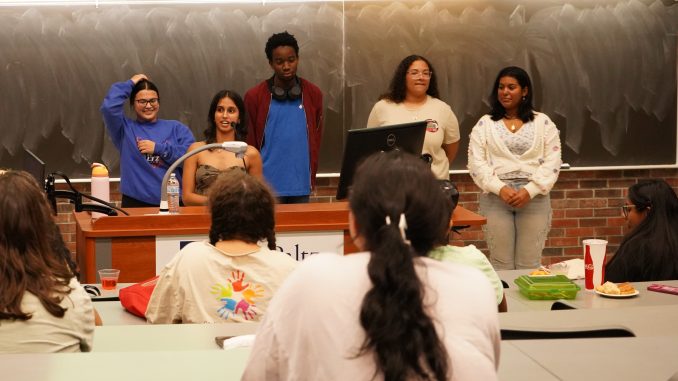
On Nov. 6 ASL Club collaborated with both Future Teachers of Color and Aspiring Educators, bringing together four panelists to discuss the complexities of sign language and its importance. The panel included Serena Wunderlich, Lynn Brickman, Melissa Mourges and Diane Barkstrom, all women who have taught sign language in schools. ASL Club President, Allyson Strobel, commented, “Previously in ASL club there wasn’t a lot of awareness of teachers of the deaf specifically … I really wanted an experience where they could see the actual stories, and see that this comes, and this is real, this is something that people can do.”
The discussion began with brief introductions from each panelist, explaining their experiences and qualifications, before opening the floor to questions from those attending in the crowd. They first talked about the importance of having sign language education, most specifically to non-hearing individuals, stressing the importance of becoming a bridge for the student towards both school officials and also their parents. In most cases, deaf people are born to hearing parents, making the educators extremely important when these individuals need to communicate their needs.
When asked about being an educator in this situation, Mourges replied, “An important trait to have as a teacher of the deaf is to be flexible, because in one day you might be in five or six different buildings.” ASL professionals serve not only as teachers, but also a resource of communication for their students, meaning they are needed in many places throughout the day and not always in the classroom. Not only is it their job to teach sign language to deaf individuals, they are also given the responsibility to stick up for their needs.
Each panelist also included the hardships they have had to face and witness as teachers of the deaf, many of them citing the difficulties they face when they see deaf students struggling and still not having their needs met by schools. Brickman said, “You have to educate, you have to keep bringing it up, you have to get parents on your side.” Awareness and exposure is a necessity to receive meaningful aid when it comes to teaching sign language.
The panel then shifted into a conversation about learning ASL, and the reality of the journey that exists while learning. With different dialects, and many signs for the same term, it can be difficult to master fluency in the language, especially when conversing with those who are fluent. Wunderlich added, “Give yourself some grace when it comes to learning.”
When it comes to discussing deafness and sign language, there is a definite barrier that exists in a culture that is not exposed to ASL as an everyday practice.
Barkstrom spoke about changing ones dialogue as they speak about matters relating to interpretation or sign language in general. “You have to change that dialogue a little bit, deaf people don’t need us, we need them.” By simply adjusting even the tone of voice when discussing deafness, the culture moves slightly in a more positive direction.

Leave a Reply
You must be logged in to post a comment.